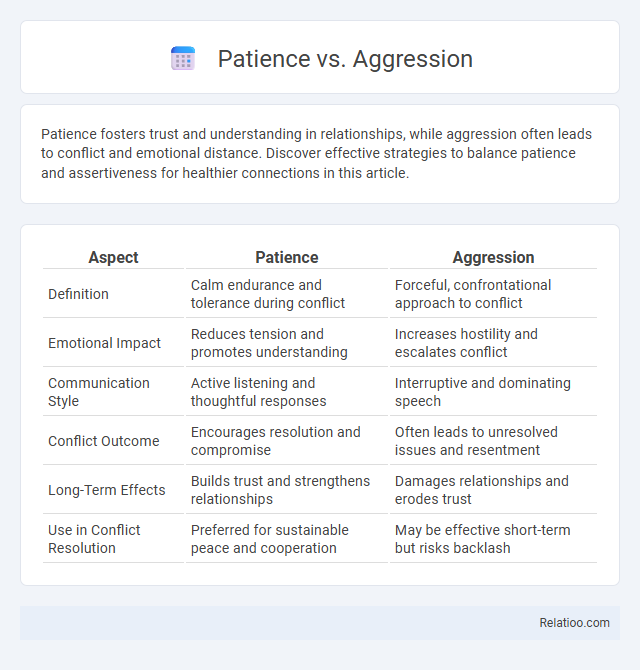Patience fosters trust and understanding in relationships, while aggression often leads to conflict and emotional distance. Discover effective strategies to balance patience and assertiveness for healthier connections in this article.
Table of Comparison
| Aspect | Patience | Aggression |
|---|---|---|
| Definition | Calm endurance and tolerance during conflict | Forceful, confrontational approach to conflict |
| Emotional Impact | Reduces tension and promotes understanding | Increases hostility and escalates conflict |
| Communication Style | Active listening and thoughtful responses | Interruptive and dominating speech |
| Conflict Outcome | Encourages resolution and compromise | Often leads to unresolved issues and resentment |
| Long-Term Effects | Builds trust and strengthens relationships | Damages relationships and erodes trust |
| Use in Conflict Resolution | Preferred for sustainable peace and cooperation | May be effective short-term but risks backlash |
Understanding Patience and Aggression
Understanding patience involves recognizing its role in fostering calm decision-making and long-term success by allowing time for thoughtful responses and reducing impulsivity. Aggression, by contrast, often triggers immediate, forceful actions driven by emotions, which may lead to conflict and short-sighted outcomes. Balancing patience and aggression requires emotional intelligence to strategically apply restraint or assertiveness based on situational demands.
The Psychology Behind Patience
The psychology behind patience reveals its foundation in emotional regulation and delayed gratification, enabling individuals to manage impulses and resist immediate rewards for long-term benefits. Neural studies highlight that patience activates the prefrontal cortex, responsible for decision-making and self-control, contrasting with aggression, which is linked to amygdala-driven emotional responses. Understanding this dynamic underscores patience as a crucial psychological trait fostering resilience, healthier relationships, and better stress management compared to aggressive reactions.
What Drives Aggressive Behavior?
Aggressive behavior is primarily driven by underlying emotional triggers such as frustration, fear, and perceived threats, which activate the brain's amygdala and stress response systems. Neurochemical imbalances involving cortisol and adrenaline further amplify aggressive impulses, leading to reactive or proactive aggression. Environmental factors, including upbringing, social context, and learned behaviors, play a critical role in shaping an individual's tendency toward aggression versus patience.
Patience vs. Aggression: Key Differences
Patience involves calmly enduring delays or challenges without frustration, fostering thoughtful decision-making and long-term success. Aggression is characterized by forceful, often impulsive actions aimed at quickly overcoming obstacles or competition, risking conflict and burnout. Your ability to balance patience versus aggression determines effective responses in high-pressure situations, optimizing outcomes through strategic persistence rather than rashness or passivity.
The Benefits of Practicing Patience
Practicing patience enhances emotional regulation and reduces stress, promoting better decision-making and long-term success compared to impulsive aggression. Patience fosters resilience and empathy, enabling individuals to navigate challenges calmly and build stronger relationships. Embracing patience over aggression leads to improved mental health and more sustainable outcomes in personal and professional settings.
The Risks Associated with Aggression
Aggression in decision-making carries significant risks, including escalating conflicts and deteriorating relationships, which may lead to long-term negative consequences. This approach often results in impulsive actions that neglect careful analysis, increasing the likelihood of errors and missed opportunities. In contrast, patience allows for better evaluation of situations, promoting thoughtful responses that minimize risks and enhance outcomes.
When Is Aggression Advantageous?
Aggression is advantageous in competitive environments where swift decision-making and assertive actions lead to seizing opportunities before rivals. In high-stakes situations like negotiations, trading, or sports, aggressive tactics can disrupt opponents' plans and establish dominance. However, balancing aggression with patience ensures optimal timing, preventing impulsive mistakes while capitalizing on breakthrough moments.
Strategies for Cultivating Patience
Cultivating patience requires deliberate strategies that enhance emotional regulation and long-term thinking. Techniques such as mindfulness meditation, cognitive reframing, and deep-breathing exercises can help you manage impulsive urges that lead to aggression. Consistently practicing these methods fosters resilience and improves decision-making in high-pressure situations.
Balancing Patience and Aggression in Decision-Making
Balancing patience and aggression in decision-making requires carefully assessing the situation to determine when to act decisively and when to wait for more information. Your ability to manage this balance maximizes opportunities while minimizing risks, ensuring optimal outcomes. Developing this skill enhances strategic thinking and improves overall judgment in complex scenarios.
Choosing the Right Approach: Context Matters
Choosing the right approach between patience and aggression depends heavily on the specific context and desired outcomes. Patience allows for thoughtful decision-making and long-term success, especially in complex situations requiring careful analysis, while aggression can drive quick results and assert dominance when immediate action is necessary. Your ability to assess the environment and adapt accordingly ensures that you apply the most effective strategy to achieve optimal results.

Infographic: Patience vs Aggression
 relatioo.com
relatioo.com